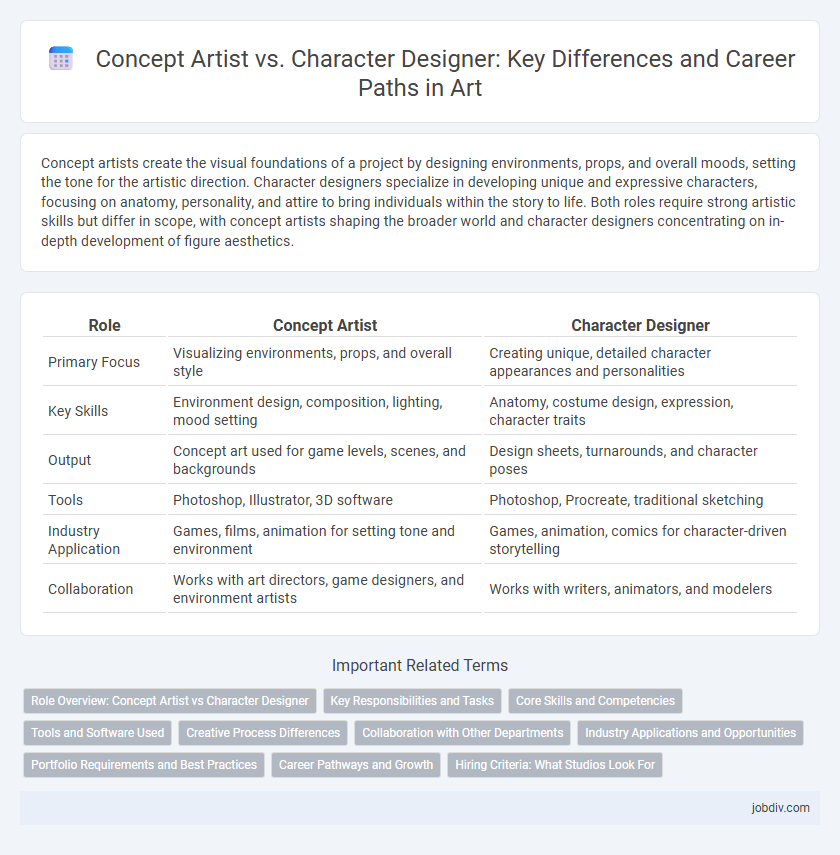Concept artists create the visual foundations of a project by designing environments, props, and overall moods, setting the tone for the artistic direction. Character designers specialize in developing unique and expressive characters, focusing on anatomy, personality, and attire to bring individuals within the story to life. Both roles require strong artistic skills but differ in scope, with concept artists shaping the broader world and character designers concentrating on in-depth development of figure aesthetics.
Table of Comparison
| Role | Concept Artist | Character Designer |
|---|---|---|
| Primary Focus | Visualizing environments, props, and overall style | Creating unique, detailed character appearances and personalities |
| Key Skills | Environment design, composition, lighting, mood setting | Anatomy, costume design, expression, character traits |
| Output | Concept art used for game levels, scenes, and backgrounds | Design sheets, turnarounds, and character poses |
| Tools | Photoshop, Illustrator, 3D software | Photoshop, Procreate, traditional sketching |
| Industry Application | Games, films, animation for setting tone and environment | Games, animation, comics for character-driven storytelling |
| Collaboration | Works with art directors, game designers, and environment artists | Works with writers, animators, and modelers |
Role Overview: Concept Artist vs Character Designer
Concept artists develop visual representations for entire scenes, environments, and moods, establishing the foundational aesthetic and atmosphere of a project. Character designers specialize in creating distinct, detailed character appearances and personalities, ensuring they align with the narrative and style of the story. Both roles require strong artistic skills, but concept artists focus on broader visual storytelling while character designers concentrate on individual character development.
Key Responsibilities and Tasks
Concept artists develop visual ideas and environments that establish the overall look and mood of a project, focusing on landscapes, objects, and settings. Character designers specialize in creating unique, detailed characters with distinct personalities, costumes, and expressions that align with the story and tone. Both roles require strong artistic skills and collaboration with directors and other creatives to ensure cohesive visual storytelling.
Core Skills and Competencies
Concept artists excel in visual storytelling, environment creation, and mood setting using skills like digital painting, composition, and color theory. Character designers focus on anatomy, personality portrayal, and unique costume design, mastering figure drawing, expression, and silhouette impact. Both roles require strong creativity and collaboration but differ in specialization: concept artists build overall scene aesthetics, while character designers concentrate on individual character identity.
Tools and Software Used
Concept artists primarily utilize software like Adobe Photoshop, Corel Painter, and Procreate for digital painting and environment visualization, emphasizing broad scene creation and atmospheric details. Character designers often rely on specialized tools such as Clip Studio Paint, ZBrush, and Autodesk Maya to sculpt, model, and refine character anatomy, expressions, and costumes. Both roles benefit from programs like Blender for 3D modeling and references, but their software choices reflect their distinct focus on environment versus character development.
Creative Process Differences
Concept artists develop broad visual ideas and environments, focusing on mood, atmosphere, and overall aesthetic to guide production teams. Character designers specialize in creating detailed, unique character visuals, emphasizing personality, pose, and costume to ensure characters fit the narrative and appeal to the audience. The creative process for concept artists is more exploratory and iterative, while character designers follow a structured approach centered on refining individual character traits.
Collaboration with Other Departments
Concept artists collaborate closely with art directors and environment designers to establish the visual style and mood of a project, ensuring cohesive world-building. Character designers work alongside animators and rigging teams to create functional and expressive character models that align with gameplay and narrative requirements. Both roles require consistent communication with production and marketing departments to maintain visual consistency and meet project deadlines.
Industry Applications and Opportunities
Concept artists excel in visualizing entire environments, props, and scenes, fueling pre-production phases in film, video games, and animation studios by providing comprehensive world-building elements. Character designers specialize in creating detailed, original character aesthetics and personalities, vital for branding, marketing, and storytelling across entertainment sectors such as gaming, comics, and animated series. Both roles offer diverse opportunities, with concept artists often engaging in broader project scopes while character designers focus on identity and emotional connection within narratives.
Portfolio Requirements and Best Practices
Concept artists emphasize environment and narrative visuals, requiring portfolios rich in diverse settings, mood studies, and storytelling elements. Character designers prioritize anatomy, expression, and costume variety, showcasing strong figure drawing skills, turnaround sheets, and personality-driven poses. Both portfolios benefit from clean presentation, consistent style, and highlighting adaptability across mediums and themes.
Career Pathways and Growth
Concept artists develop broad visual ideas and environments, often working on initial stages of projects in video game and film industries, while character designers specialize in creating detailed, expressive character visuals central to storytelling. Career growth for concept artists typically involves advancing to roles like lead concept artist or art director, emphasizing versatility in style and expansive visual creativity. Character designers progress by refining skills in anatomy and personality expression, often moving toward senior design positions or taking on character art supervisor roles in studios.
Hiring Criteria: What Studios Look For
Studios prioritize concept artists who demonstrate strong storytelling skills, versatility in environments and props, and the ability to visualize abstract ideas into compelling visuals. Character designers must showcase expertise in anatomy, unique personality portrayal, and the creation of versatile designs suited for animation or game mechanics. Both roles demand proficiency in industry-standard software and a robust portfolio that highlights creativity and technical skill aligned with the studio's project style.
Concept Artist vs Character Designer Infographic

 jobdiv.com
jobdiv.com